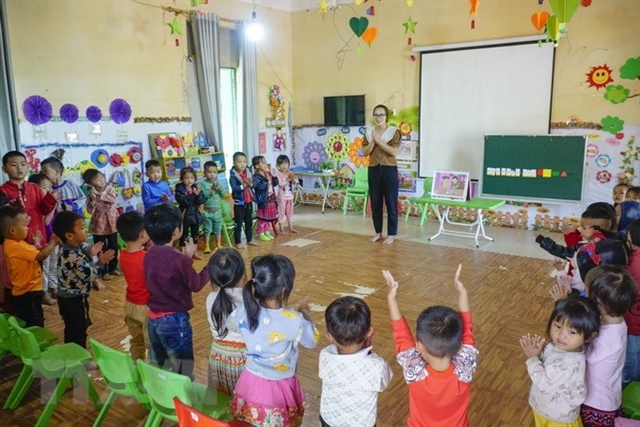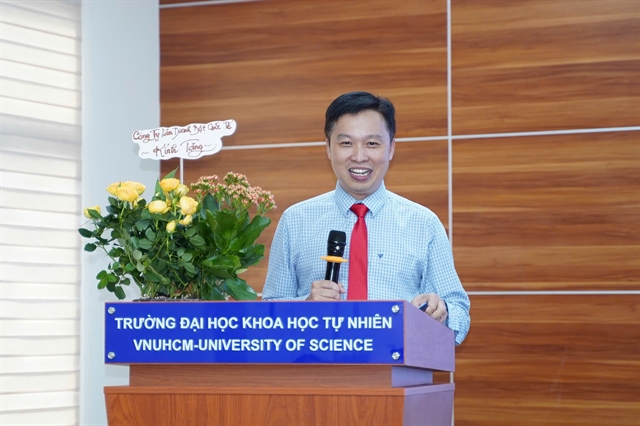 Society
Society

 |
| Students learn Vietnamese at Nà Bủng Pre-school in northern Điện Biên Province. VNA/VNS Photo Xuân Tư |
HÀ NỘI — Many teachers in the northern mountainous province of Điện Biên have strived to self-learn ethnic languages to help children from ethnic groups gain confidence in communication and gradually excel in their Vietnamese classes.
As a result, cultural barriers have gradually been lifted, and the transmission of knowledge has been more effective.
Ta Ma Commune’s Pre-school is located approximately 40km from Tuần Giáo District in Điện Biên Province. The school has 462 students, with the majority Mông and Kháng whose mother tongue was the only language they’re accustomed to.
Upon arriving at school, the teachers speak Vietnamese (the official language of Việt Nam and is spoken by the majority of Vietnamese people), and the educational curriculum is also conducted in Vietnamese. Language differences between the teachers and students have posed significant challenges.
Hà Thị Mến, vice principal of the pre-school, said local children were entirely unfamiliar with Vietnamese language when they entered school. Some couldn't even express their basic needs when they wanted water or use the restroom. The language barrier made children more timid and less confident in class.
“To ensure quality of teaching and learning, all 29 teachers at the school registered to learn ethnic language," Mến told the online newspaper giaoducthoidai.vn.
"Only through this approach can teachers and students find a common language.”
Teachers actively engaged in self-learning through practical experiences to facilitate communication with parents and students. They regularly sought support from parents, not only in communicating with their children at home but also in assisting teachers with translation and enhancing poems and songs in both languages to make them more memorable and understandable for the children.
In addition to the two Vietnamese language classes per week, the school also integrated Vietnamese language into all classroom activities.
Teacher Tòng Thị Lan said she plays traditional folk games with short and easy-to-remember common language songs, which helped increase interaction with students.
"We often teach folk songs and riddles to make learning enjoyable and engaging for the children. Many folk songs have been translated into both languages to help children learn faster,” she said.
Previously, Lan was assigned to a preschool in the Phình Cứ Village, where all of the students were Mông. She faced challenges in communicating with the children as well as their parents as none of them could speak Vietnamese language.
She said: "I had to get acquainted with the children, using body language and communicating word by word, repeating each word or phrase until the children understood me. I also learned the Mông language from village elders and parents.
"Thanks to this, by the middle of the first semester, I could understand my students and better communicate with them."
At Tỏa Tình Commune’s Pre-school in Tuần Giáo District, all students were Mông and communicated in their native language. During lessons, the teachers often used the native language to help children understand the meaning and then translate it into Vietnamese.
Principal Nguyễn Hương Diễm said: "The school always emphasises to strengthen Vietnamese language for children. We integrate teaching Vietnamese into learning activities, including local language, so that children can read, pronounce, and speak in both languages. This makes children more enthusiastic, understanding, and able to remember their lessons better."
The school placed Vietnamese alphabet letters in the play area so that children could practise pronunciation anytime and anywhere. The teachers also encouraged the students to communicate in Vietnamese.
During extracurricular activities, the school required teachers to focus on improving listening, speaking, reading, and writing skills in Vietnamese for the children.
Teacher Cao Thị Nhung said: "The teachers create educational materials and toys related to Vietnamese alphabet letters for the children, such as letter spinning games, alphabet handprints, and alphabet flower decorations. We also have a library, play corner, and classrooms with a variety of books to allow children to access common language materials more frequently."
Diễm said each school might have its own methods and solutions, the goal was to help children understand and communicate effectively in Vietnamese language, absorb lessons better, and enhance the quality of teaching and learning. – VNS




